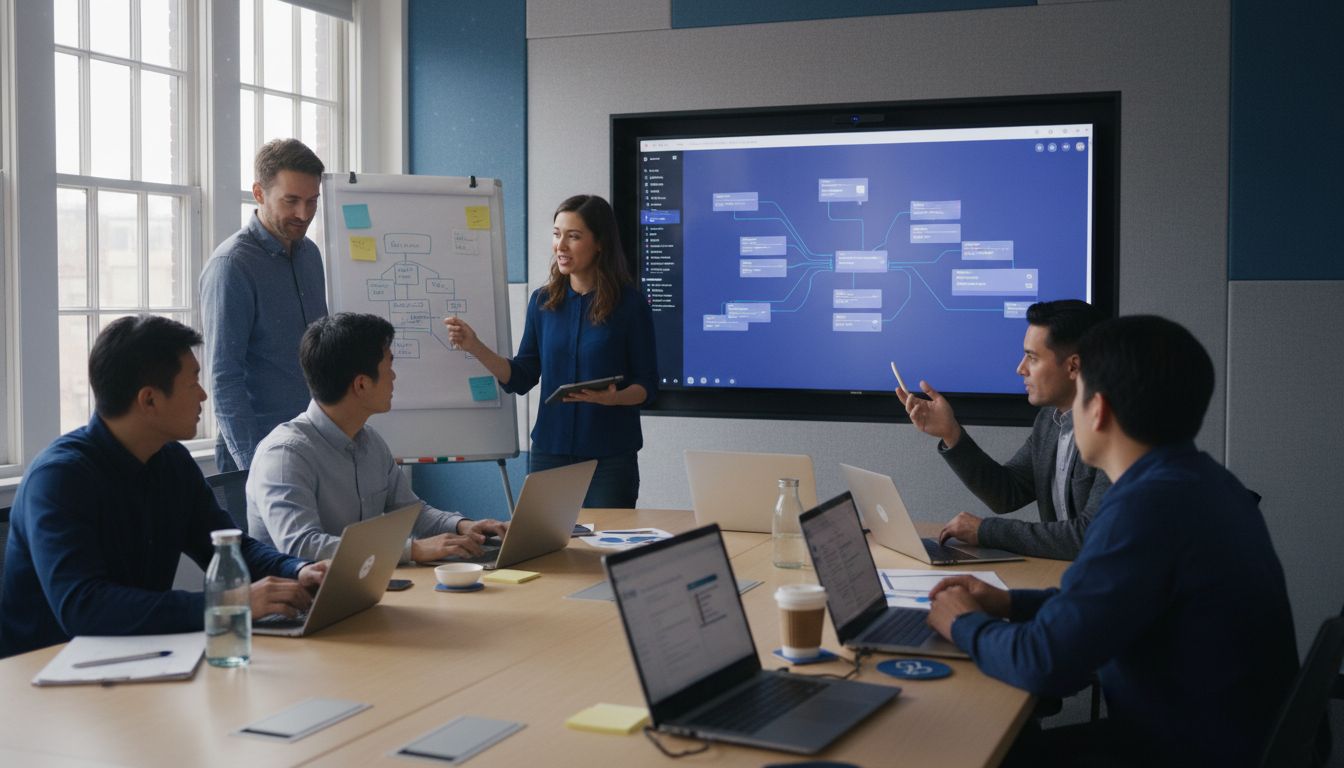Meta title: From Requirements to Support: Full Lifecycle Management | Singleclic
Meta description: See how Singleclic delivers full lifecycle management—from requirements and architecture to development, testing, deployment, and 24/7 support—using ERP, CRM, low-code, cybersecurity, networking, and cloud hosting.
URL slug: from-requirements-to-support-full-lifecycle-management
Primary keyword: From Requirements to Support: Full Lifecycle Management
Secondary keywords: requirements life cycle management, full software lifecycle, requirement analysis steps, data lifecycle stages, IT project delivery, application support services
Why Full Lifecycle Management Matters for Modern IT
Delivering software that actually solves business problems requires more than code. It demands a disciplined approach that spans requirements, design, development, testing, deployment, operations, and continuous support. At Singleclic—a leading IT solutions provider since 2013 serving organizations across the Arab world—we unify people, processes, and platforms to reduce risk, accelerate time to value, and keep your systems secure and scalable.
What We Mean by “From Requirements to Support”
We manage the end-to-end lifecycle of your solution:
- Requirements & Analysis: Clarify goals, constraints, and success metrics with stakeholders.
- Architecture & Design: Choose scalable architectures, data models, and integrations.
- Build & Configuration: Develop custom software and configure ERP/CRM and low-code apps.
- Quality Assurance: Validate functionality, performance, and security before go-live.
- Release & Deployment: Orchestrate cloud-ready releases with rollback plans.
- Operate & Optimize: Monitor, secure, and tune environments for reliability.
- Support & Success: Provide 24/7 technical support and continuous improvement.
We integrate Low-Code, ERP, CRM, Networking, Cybersecurity, and Cloud Hosting so your solution works as one system—not a patchwork.
Our Lifecycle Capabilities at a Glance
1) Requirements & Analysis (Business and Technical)
- Stakeholder interviews, user journeys, and process mapping
- Prioritization frameworks (MoSCoW, RICE) and clear acceptance criteria
- Compliance and data-privacy considerations baked in from day one
2) Architecture & Design
- Domain-driven designs and modular service boundaries
- Cloud-native patterns and secure network topologies
- Integration plans for ERP/CRM, data pipelines, and third-party services
3) Build: Custom Development + Low-Code
- Rapid prototypes in low-code to validate quickly
- Robust back-end and front-end engineering for scale
- ERP/CRM configuration aligned to real business workflows
4) Testing & Validation
- Functional, regression, and UAT cycles with traceability to requirements
- Performance testing for peak loads; security testing for threats
- Test automation to shorten feedback loops
5) Release & Deployment (DevOps)
- CI/CD pipelines, Infrastructure-as-Code, immutable builds
- Staged rollouts (blue-green/canary) and automated rollbacks
- Audit trails and change management aligned to ITIL
6) Operate, Monitor & Secure
- Centralized logging, metrics, and alerting (SLA/SLO focus)
- Cybersecurity controls: WAF, IAM, encryption, vulnerability scans
- Cost governance and performance optimization in the cloud
7) Support & Continuous Improvement (24/7)
- Multi-tier helpdesk, root-cause analysis, and knowledge base
- Proactive maintenance, patching, and capacity planning
- Iterative roadmap updates based on usage analytics and ROI
Requirements Life Cycle Management: What It Covers
Definition: Requirements life cycle management ensures that business and technical requirements are elicited, analyzed, documented, traced, validated, maintained, and governed from inception to retirement. It connects every change to measurable business outcomes and keeps scope aligned with value.
Core outcomes:
- Clear traceability from requirement → test → release
- Faster change approval with predictable impact analysis
- Reduced rework, improved stakeholder confidence, and audit readiness
The 7 Steps in Requirement Analysis (Practical View)
- Elicit: Collect needs through interviews, workshops, and system reviews.
- Analyze: De-duplicate, refine, and spot conflicts or dependencies.
- Document: Write concise, testable requirements with acceptance criteria.
- Validate: Confirm with stakeholders that requirements match business goals.
- Prioritize: Rank by value, risk, and effort; align with release plans.
- Trace: Link requirements to design, tests, and releases for full visibility.
- Maintain: Update as the business evolves; manage versions and approvals.
Full Lifecycle Management vs. Traditional Project Delivery
| Dimension | Traditional Approach | Full Lifecycle Management (Singleclic) |
|---|---|---|
| Scope | Project-bounded | Product-oriented, continuous value |
| Speed | Linear handovers | Iterative with DevOps automation |
| Quality | Late QA | Shift-left testing + observability |
| Security | Afterthought | Security-by-design + continuous controls |
| Support | Post-go-live only | 24/7 with proactive optimization |
Where Data Fits In: The 5 Stages of Data Lifecycle Management
- Creation/Capture – Ingest from apps, IoT, forms, and integrations
- Storage – Classify and store securely (encryption, backup, retention)
- Use/Processing – Clean, transform, and analyze for decisions and AI/ML
- Sharing/Archiving – Govern access, maintain lineage, and archive compliantly
- Deletion/Disposal – Retire safely per policy, industry, and legal standards
Our networking and cybersecurity teams build the guardrails for every stage—identity management, least-privilege access, and continuous monitoring.
Singleclic’s Differentiators
- Since 2013: A decade+ serving enterprise and mid-market in the Arab region
- Integrated portfolio: Low-code, ERP, CRM, Networking, Cybersecurity, Cloud Hosting
- Governed delivery: Requirements traceability, DevOps, and ITIL-aligned support
- 24/7 support: Always-on coverage with measurable SLAs
- Business outcomes first: We map technology to clear KPIs and ROI
Use Cases We Deliver
- ERP & CRM transformations with seamless integrations
- Customer portals & mobile apps built rapidly on low-code
- Secure cloud migrations with high availability and cost control
- Data platforms for analytics, dashboards, and AI-ready pipelines
Implementation Timeline (Illustrative)
H2 – Phase 1: Discovery & Architecture (Weeks 1–3)
- Workshops, requirement baselining, solution blueprint, backlog
H2 – Phase 2: Build & Validate (Weeks 4–10)
- Iterative sprints, demos, automated tests, security reviews
H2 – Phase 3: Release & Hypercare (Weeks 11–12)
- Production cutover, performance tuning, knowledge transfer
H2 – Ongoing: Operate & Optimize (Month 4+)
- 24/7 support, enhancements, and KPI-driven improvements
People Also Ask (FAQ)
What is requirements life cycle management?
Requirements life cycle management is the discipline of governing requirements end-to-end—from elicitation and documentation to validation, traceability, change control, and retirement—so every release delivers verifiable business value.
What is full lifecycle management?
Full lifecycle management covers the complete journey of a solution: requirements, design, build, testing, deployment, operations, and 24/7 support. It treats products as living systems that evolve with the business—backed by DevOps, observability, and strong security.
What are the 7 steps in requirement analysis?
Elicit, Analyze, Document, Validate, Prioritize, Trace, Maintain. These steps keep scope aligned, reduce rework, and ensure high-quality delivery.
What are the 5 stages of data lifecycle management?
Creation/Capture, Storage, Use/Processing, Sharing/Archiving, Deletion/Disposal. Each stage requires controls for security, compliance, and cost efficiency.
Call to Action
Want a partner who owns the outcome from requirements to 24/7 support?
Talk to Singleclic today:
- Egypt: +2 010 259 99225
- UAE: +971 42 475421
- KSA: +966 58 1106563
- Website: https://singleclic.com/
We’ll help you plan the roadmap, deliver faster with low-code where it fits, secure your stack, and keep your systems running smoothly—day and night.









